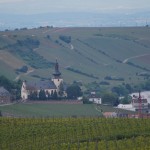Most Americans know that Germans love beer. But how many of us know the importance of wine? If you’ve ever traveled to the Mosel, the largest tributary of the Rhine, you know that every square inch of space, no matter how steep, no matter how remote is covered with the vines of wine. But you’ll also find vineyards along the Rhine, Main, Nahe and in south-west Germany.

Compared to its neighbor, France, Germany’s wine is mostly white. The famous Riesling comes to mind, but also white and gray burgundies (pinot blanc and grigio respectively), Rivaner, Silvaner and the newest German invention, the red Dornfelder, play a major role in Germany’s wine repertoire. Unfortunately, most of the country’s wine never sees the border, not to mention U.S. markets. Rather, the small quantities, produced by hundreds of family farms are sold to tourists, restaurants and maybe a few grocery stores—and of course consumed locally. And what is exported to our shops is mostly not worth drinking.
So, when we stopped in Oppenheim, a tiny medieval village on the Rhine south of Frankfurt, we decided to participate in a vineyard tour. Not just any tour, but one offered by the Weingut Dr. Heyden. Along with 11 friends, we climbed into a covered wagon that was pulled by a tractor. Let the adventure begin…

As soon as we had reached the first pass with a glorious view of the Rhine River below us, the tractor stopped and we had our first taste. For this, the wagon is equipped with two benches and a simple table, on which two empty cans serve as bottle holders. Ingeniously easy. Then come the tasting glasses and what goes into them. Compared to many white wines available in the U.S., the German varieties contain a lot less acid. I don’t know enough about wine to explain why, but let it suffice to say that most German wines are smooth and enjoyable. And best of all they are cheap. Many of the varieties we tried ran about $5 to $8 a liter.

After the first bottle was killed, our guide continued about a hundred feet after which he stopped to introduce the next bottle. And another 75 yards after that followed the third. You get the picture. Meanwhile our group became more and more engaged in learning (and immediately forgetting) all they could about vineyards. Our host knew it all. The stocks, the ages when they produce and when they get too old, the varietals and how they defer, the diseases that are treatable and the ones that are not. Like a new type of fungus (sorry, the wine has claimed my memory of its name) that takes hold and destroys the plant. Irreversibly.

Six bottles later we took a break and were provided with a baked Brötchen, mustard and Fleischwurst sausage, a type of bologna slightly longer than a hot dog, but much thicker. Sufficiently restored we continued along the ridges of the Oppenheimer hills, one vista more magnificent than the next and you guessed it…more wine. We could even see downtown Frankfurt and the huge barges schlepping on the Rhine. As our group’s volume increased significantly, our guide decided to add to the merriment by doing doughnuts with the tractor. Even from my seat I could detect a sly grin on his face. We kept going around in a circle until hills, sky and faces turned into a blur. Or maybe that was partly the wine.
Of course, all this excitement was reason for more wine. By the time we returned to our hotel, we had spent four hours—two hours had been planned—and drunk and learned quite a lot. It was unforgettable and we thank the Dr. Heyden Family Vineyard for their amazing tour.
